Needlework, types of stitches, and embroidery have been used for centuries in decorating fabric. The art of using threads into beautiful and eye-catching threadwork is called embroidery. Embroidery is one of the most diverse forms of skill that is enriched with many cultural heritages.
The dedicated craftsmen around the world have their styles of embroidery that the world cherishes. It does not matter if the embroidery is done by hand or by a machine; it is always beautiful.
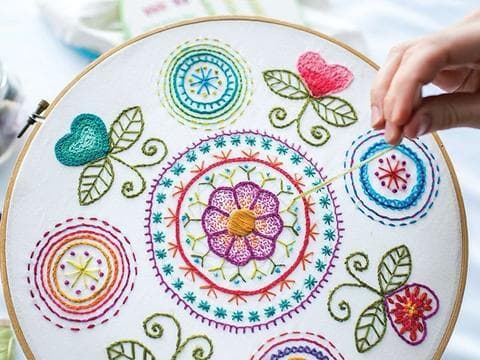
Let us take you on a journey of different types of embroidery techniques that the world is obsessing over. Many artisans use these embroideries alone or together to create unforgettable masterpieces for you.
Types of Embroidery
1. Counted Thread Embroidery
The counted thread technique is one of the basic techniques among different types of hand embroidery. As the name suggests, this embroidery involves counting the number of threads for each stitch. Therefore, the embroidery has all symmetrical stitches and can be used in making many beautiful patterns.
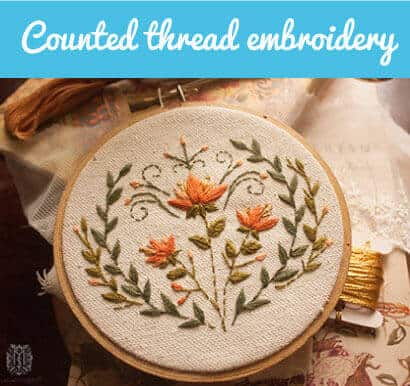
2. Crewel Embroidery
Crewel embroidery, also known as crewelwork, uses yarns for the thread. Since the yarn is thicker than the cotton thread usually used in the embroidery, the embroidery has more texture and body. It is a perfect choice for tapestries and decorating cushion covers and blankets to give your bedding a stylish look.

3. Whitework Embroidery
Whitework Embroidery is unknown as French Laid work too. As the name implies, the whitework uses white fabric and white thread floss to make amazing patterns. It is based on many beautiful techniques to bring innovative designs.
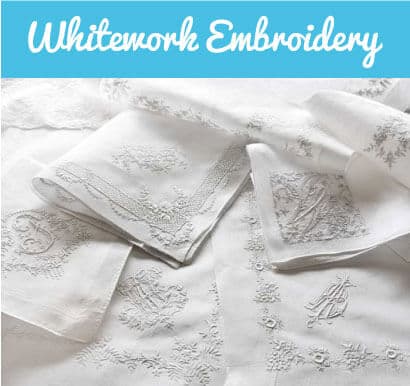
4. English Embroidery
English Embroidery or Broderie Anglaise is one of the oldest embroidery techniques. It is associated with the regal English Century. This embroidery uses the base technique of whitework embroidery and uses a pattern of lace and cutwork altogether. This gives a royal look to your clothing.
5. Patchwork Embroidery
Patchwork by embroidering the small pieces of fabric onto another fabric as a base is a beautiful art. The fabric arrangement creates a beautiful design while the edges are concealed with the thread of choice.
Whether you use a machine or get it done by the needle, it still is gorgeous and can be used in many ways. The most typical form of utilizing the patchwork embroidery technique is in making quilts and cushions. But modern fashion also uses it in women’s clothing.

6. Candlewicking Embroidery
It is no surprise that the Candlewicking embroidery is also based on whitework embroidery and an old stitching technique called a colonial knot. The colonial knots create a design line that is ideal for borders. It uses a heavy and unbleached cotton thread—also the traditional way to make it in unbleached cloth or muslin.
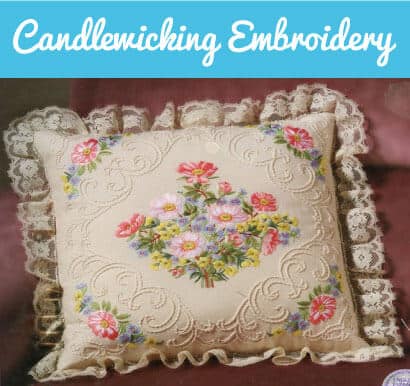
7. Cross Stitch Embroidery
Cross stitch embroidery makes the “X” or cross stitches into a pattern. Usually, it uses the basics of counted thread for even and eye-catchy designs. Many artisans or machines are using a graph or grid format for symmetrical results.
Women in the Sub-continent use this embroidery for their drapes, bed sheets, and clothing.
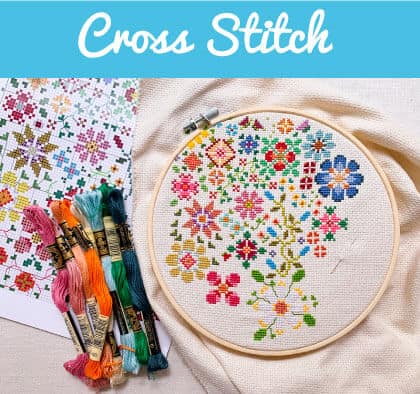
8. Shadow Work Embroidery
Shadow work embroidery is another beautiful style that is very popular in the Sub-continent for women’s clothing.
The herringbone stitch is usually made with a medium-thick cotton thread. The transparent or semi-transparent fabric is used as a base so that the embroidery is visible. The fabrics traditionally used are lawn, organza, batiste, muslin, georgette, or any lightweight and semi-sheer fabric.

9. Fish Scale Embroidery
Surprisingly, the embroidery replicates the scale of the fish as a design. For many centuries, the fish scale embroidery was done over the velvet and worn by the women.
The technique of fish scale embroidery is followed by creating base circles or holes, and then the scales like shapes are embroidered into flowers, fish, or patterns. This technique is ideal for tapestries and women’s clothing.
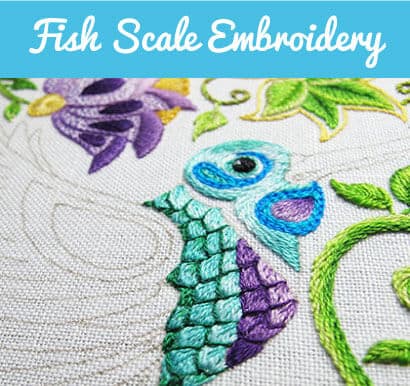
10. Pulled Thread Embroidery or Drawn Thread Embroidery
Pulled thread embroidery or Drawn Thread Embroidery is a cross between whitework and counted thread embroideries. The thread or group of threads are embroidered so that when tightened, it creates a mosaic and gaps.
The fabric is usually used in fine and soft, like lawn and loosely woven linen or cotton. It is ideal for making laces, borders for bed sheets, tablecloths, and table runners. Pulled thread embroidery is suitable for making hems for women’s clothing.
Another form of such embroidery is called Hedebo, which originated in Denmark in the early 15th Century. Hedebo embroidery was trendy for making hem laces for the royals, noblemen, and affluent families.
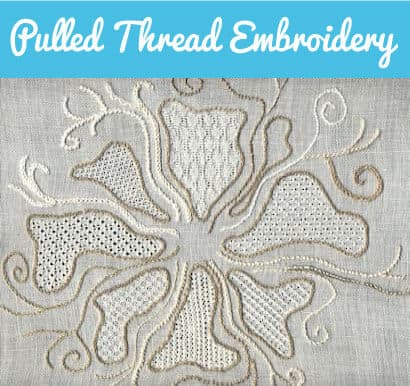
11. Blackwork Embroidery
Blackwork Embroidery first originated in Spain and had the base of counted thread embroidery. The traditional way was to use the fine black thread on any white or colored cloth, but the different kinds of black threads were involved as time passed. Multiple styles of stitches are used in this embroidery for tapestries and clothing.
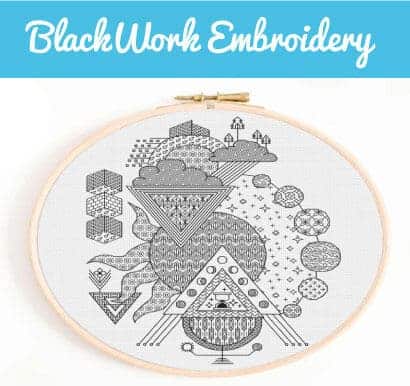
12. Hardanger Embroidery
Hardanger embroidery is like a distinct cousin of drawn thread embroidery. It originated in a city in Norway called Hardanger, as the name indicates. This technique uses the cutwork technique, and satin stitches draw and pull the thread to make geometric and intricate designs where the drawn or pulled thread embroidery technique does not use cutwork.
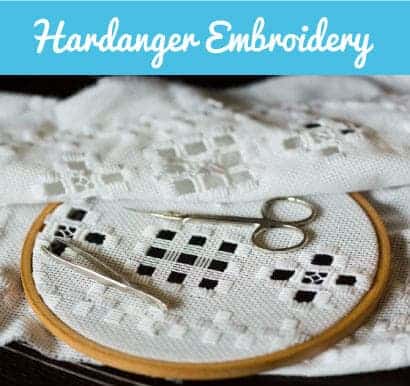
13. Huck Embroidery
Huck embroidery, also known as Swedish weaving, is restricted to the huckaback fabric and uses a darning stitch for designing. It also uses a special kind of needle called a “Blunt needle” or cotton floss needle. It is a fantastic choice for beginners because the fabric has a visible pattern on it. The beginner can easily make geometric designs without any graph and pre-drawn assistance.
People get very creative with it since the material is ideal for tapestries, table runners, and decoration.
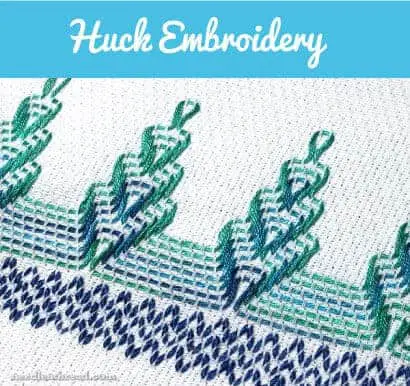
14. Sashiko Embroidery
Sashiko Embroidery originated in Japan. It uses a fine thread and uses a running stitch to make the geometric and symmetrical design look tremendous.
Traditionally the fabric used for sashiko embroidery is always dark, and the thread is always light. It is very minimalistic and always ideal for decorative fabric for wall hangings. One of the typical designs is the overlapping circles made with running stitches. This gives a decent look at your personality.

FAQs:
- Can you use machine embroidery thread for hand embroidery?
Yes, you can use machine embroidery thread for hand embroidery. The results are pretty much the same and there is hardly any difference between them both. There is no change in the process as well. You can easily use the machine embroidery threads for regular hand embroidery. However, you need to be careful about which material you are using. This is due to the fact that these machine threads are made to handle different wear and tear situations. There is nothing else you need to worry about.